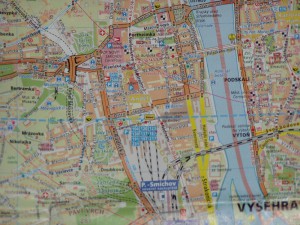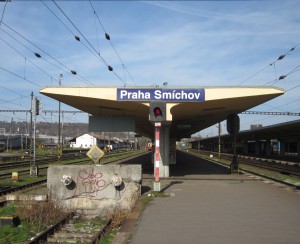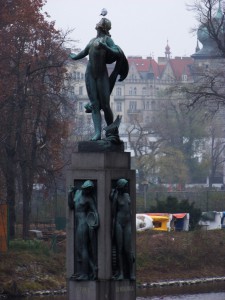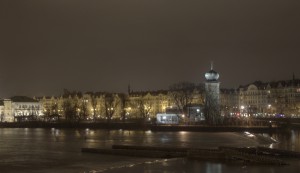
If there is a district in Prague where, more than anywhere else, modernity and the past coexist more or less harmoniously, this is surely Smíchov.
 Located on the west bank of the Vltava river, the district forms part of the Prague 5 district and is now at the centre of a process of transformation which, although less rapid than in other areas of the city, is surely destined to completely redefine the aspect of the place. Smíchov lies between Malá Strana, which delimits the northern border and Hlubočepy, whilst in the South-West, it borders with Radlice. It is bounded by Plzeňská street , a vital artery for the city traffic, and by the Motol area, the premises of one of the city’s main hospitals. Smíchov is also part of the artificial island of Císařská louka where, according to tradition, the coronation of the Czech king Wenceslas II took place in 1297. The area, which used to be rural, goes back to the Middle Ages, but began its growth and full development only after the Industrial Revolution. Particularly important for Smíchov was the construction of the railway that connects Prague with the western part of Bohemia, and in 1862 the construction of the Nádraží Praha-Smíchov station (Smíchovské Nádraží). The station was built as a terminus for the Prague-Plzeň connection, to facilitate the transport of growing numbers of goods and passengers. According to statistics, an average of around 4 million passengers benefit from the railway station, and this soon led to the development of shops and offices all around. The station itself was rebuilt in 1953 and was designed by the architects Jan Zázvorka and Ladislav Žák. Smíchov has long been the centre of heavy industry factories, which include plants for the construction of railway carriages, located close to the banks of the Vltava river.
Located on the west bank of the Vltava river, the district forms part of the Prague 5 district and is now at the centre of a process of transformation which, although less rapid than in other areas of the city, is surely destined to completely redefine the aspect of the place. Smíchov lies between Malá Strana, which delimits the northern border and Hlubočepy, whilst in the South-West, it borders with Radlice. It is bounded by Plzeňská street , a vital artery for the city traffic, and by the Motol area, the premises of one of the city’s main hospitals. Smíchov is also part of the artificial island of Císařská louka where, according to tradition, the coronation of the Czech king Wenceslas II took place in 1297. The area, which used to be rural, goes back to the Middle Ages, but began its growth and full development only after the Industrial Revolution. Particularly important for Smíchov was the construction of the railway that connects Prague with the western part of Bohemia, and in 1862 the construction of the Nádraží Praha-Smíchov station (Smíchovské Nádraží). The station was built as a terminus for the Prague-Plzeň connection, to facilitate the transport of growing numbers of goods and passengers. According to statistics, an average of around 4 million passengers benefit from the railway station, and this soon led to the development of shops and offices all around. The station itself was rebuilt in 1953 and was designed by the architects Jan Zázvorka and Ladislav Žák. Smíchov has long been the centre of heavy industry factories, which include plants for the construction of railway carriages, located close to the banks of the Vltava river.
The district retained its industrial appearance until the first half of the twentieth century and partly during communism.  Between 1903 and 1921, Smíchov was actually a real town and became part of the Municipality of Prague in 1922. Despite its central location, it has long been considered a second class neighbourhood, just as Karlín, Žižkov and Holešovice were: because of a certain urban decay which the neighbourhood was subject to in the past, and partly, but to a small extent, also today; both for the presence of heavy industries which, for a long time have compromised the quality of life and have had a negative impact on urban landscape. Smíchov is well known to the people of Prague, also for the large presence of its citizens of Roma origin, who during the communist period were allocated in this area, as well as in other districts of the city, following the prohibition of nomadism. Whilst in Prague the Roma population has been integrated with minor problems compared to other cities in the Czech Republic, the district has long been exaggeratedly considered a kind of ghetto: an aspect that has surely slowed down its modernization.
Between 1903 and 1921, Smíchov was actually a real town and became part of the Municipality of Prague in 1922. Despite its central location, it has long been considered a second class neighbourhood, just as Karlín, Žižkov and Holešovice were: because of a certain urban decay which the neighbourhood was subject to in the past, and partly, but to a small extent, also today; both for the presence of heavy industries which, for a long time have compromised the quality of life and have had a negative impact on urban landscape. Smíchov is well known to the people of Prague, also for the large presence of its citizens of Roma origin, who during the communist period were allocated in this area, as well as in other districts of the city, following the prohibition of nomadism. Whilst in Prague the Roma population has been integrated with minor problems compared to other cities in the Czech Republic, the district has long been exaggeratedly considered a kind of ghetto: an aspect that has surely slowed down its modernization.
 However, this belongs to the past and Smíchov is preparing itself for the future, which foresees innovation and regeneration of its urban areas in a multicultural context and, hopefully, with greater tolerance for diversity. The origin of the name of this suburb of Prague is not very clear. According to legend, it derives from the Czech term “Smích”, “laughter”, the same word that the legendary and popular Horymír, a character of Slavic mythology, is supposed to have said when he jumped into the river from the fortress of Vyšehrad with his faithful steed Šemík and managed to get to the other side of the Vltava, saving himself from a death sentence. However, according to another theory, the name of the district derives from the landowner, Jan Smíchovský, who in 1430 purchased the land, where subsequently, he developed the city centre. However, the most likely theory is that the name became widespread after 1386, when Charles IV turned this territory into a place where to accommodate people coming from various regions, who “mingled” and is named “smíchání” in Czech. Although destroyed during the Thirty Years War, Smíchov was entirely rebuilt starting from the seventeenth century, when a few nobles began to buy the land on which to build their summer residences in view of its favourable position close to the then city of Prague.
However, this belongs to the past and Smíchov is preparing itself for the future, which foresees innovation and regeneration of its urban areas in a multicultural context and, hopefully, with greater tolerance for diversity. The origin of the name of this suburb of Prague is not very clear. According to legend, it derives from the Czech term “Smích”, “laughter”, the same word that the legendary and popular Horymír, a character of Slavic mythology, is supposed to have said when he jumped into the river from the fortress of Vyšehrad with his faithful steed Šemík and managed to get to the other side of the Vltava, saving himself from a death sentence. However, according to another theory, the name of the district derives from the landowner, Jan Smíchovský, who in 1430 purchased the land, where subsequently, he developed the city centre. However, the most likely theory is that the name became widespread after 1386, when Charles IV turned this territory into a place where to accommodate people coming from various regions, who “mingled” and is named “smíchání” in Czech. Although destroyed during the Thirty Years War, Smíchov was entirely rebuilt starting from the seventeenth century, when a few nobles began to buy the land on which to build their summer residences in view of its favourable position close to the then city of Prague.
Today, the area is also well known for its large brewery close to the river where there used to be factories for the  construction of trains. The Pivovar Staropramen brewery was founded in 1871 and began producing beer on May 1st of that year. It is one of the largest breweries in the Czech Republic and offers visitors tours and tastings of “liquid bread ” of the Czechs, famous throughout the world. Among the special sights and attractions in the neighbourhood, there is Bertramka Villa, where Wolfgang Amadeus Mozart lived in the late eighteenth century. It was here, in 1787, that the great Austrian genius completed his masterpiece “Don Giovanni”, whose first performance took place in Prague, at the Estates Theatre, on October 29 of the same year. There is a permanent exhibition inside dedicated to Mozart, which includes objects, musical instruments, and the first Don Giovanni playbill. There is a beautiful garden around the Villa, which is particularly pleasant during the spring and autumn seasons.
construction of trains. The Pivovar Staropramen brewery was founded in 1871 and began producing beer on May 1st of that year. It is one of the largest breweries in the Czech Republic and offers visitors tours and tastings of “liquid bread ” of the Czechs, famous throughout the world. Among the special sights and attractions in the neighbourhood, there is Bertramka Villa, where Wolfgang Amadeus Mozart lived in the late eighteenth century. It was here, in 1787, that the great Austrian genius completed his masterpiece “Don Giovanni”, whose first performance took place in Prague, at the Estates Theatre, on October 29 of the same year. There is a permanent exhibition inside dedicated to Mozart, which includes objects, musical instruments, and the first Don Giovanni playbill. There is a beautiful garden around the Villa, which is particularly pleasant during the spring and autumn seasons.
 Another monument of particular historical and architectural interest is the Smíchovská Synagogue that was built in 1863 in neo-Romanesque style and rebuilt in 1931 according to the monumentality criteria based on a project by Leopold Ehrmann. In 1941, the synagogue was used by the Nazis as a warehouse for the personal belongings taken from the Jews in Prague. On the facades of the Synagogue there are two writings in Czech and Jewish which cite two passages from the Bible (Isaiah 57:19 and Zechariah 4:16). The Hebrew inscription, according to the method of combining numbers and letters of the alphabet known as Gematria, gives as a result number 5691, the Jewish year of the reconstruction of the Synagogue.
Another monument of particular historical and architectural interest is the Smíchovská Synagogue that was built in 1863 in neo-Romanesque style and rebuilt in 1931 according to the monumentality criteria based on a project by Leopold Ehrmann. In 1941, the synagogue was used by the Nazis as a warehouse for the personal belongings taken from the Jews in Prague. On the facades of the Synagogue there are two writings in Czech and Jewish which cite two passages from the Bible (Isaiah 57:19 and Zechariah 4:16). The Hebrew inscription, according to the method of combining numbers and letters of the alphabet known as Gematria, gives as a result number 5691, the Jewish year of the reconstruction of the Synagogue.
 The heart of Smíchov is now in the “Anděl” area, near the homonymous metro station, which used to be called “Moskevská” and also known for being one of the settings where in 1995 the Czech award-winning movie “Kolya” was filmed, directed by Jan Svěrák and Oscar winner in 1996 for the best foreign film. Andel is the most vital part and the economic centre of the district, with its modern architecture buildings and the premises of multination corporation companies and offices. A few meters from the metro station, and on one of the main hubs of the city’s tram traffic, there is the modern shopping centre “Novýhttp://www.progetto.cz/smichov-incontro-di-armonici-contrasti/?lang=it Smíchov”, one of the largest malls in the city that is visited daily by thousands of people. Smíchov is often the scene of cultural events, especially in summer, and in recent years, thanks to the two multiplex cinemas within easy walking distance of each other, it has become a point of reference for Prague cinephiles. One of the most important annual cultural events of the district is definitely the Febio Fest International Film Festival in Prague, which in 2013 is now in its twentieth edition.
The heart of Smíchov is now in the “Anděl” area, near the homonymous metro station, which used to be called “Moskevská” and also known for being one of the settings where in 1995 the Czech award-winning movie “Kolya” was filmed, directed by Jan Svěrák and Oscar winner in 1996 for the best foreign film. Andel is the most vital part and the economic centre of the district, with its modern architecture buildings and the premises of multination corporation companies and offices. A few meters from the metro station, and on one of the main hubs of the city’s tram traffic, there is the modern shopping centre “Novýhttp://www.progetto.cz/smichov-incontro-di-armonici-contrasti/?lang=it Smíchov”, one of the largest malls in the city that is visited daily by thousands of people. Smíchov is often the scene of cultural events, especially in summer, and in recent years, thanks to the two multiplex cinemas within easy walking distance of each other, it has become a point of reference for Prague cinephiles. One of the most important annual cultural events of the district is definitely the Febio Fest International Film Festival in Prague, which in 2013 is now in its twentieth edition.
This article, written by Mauro Ruggiero, was originally published in: Progetto Repubblica Ceca




